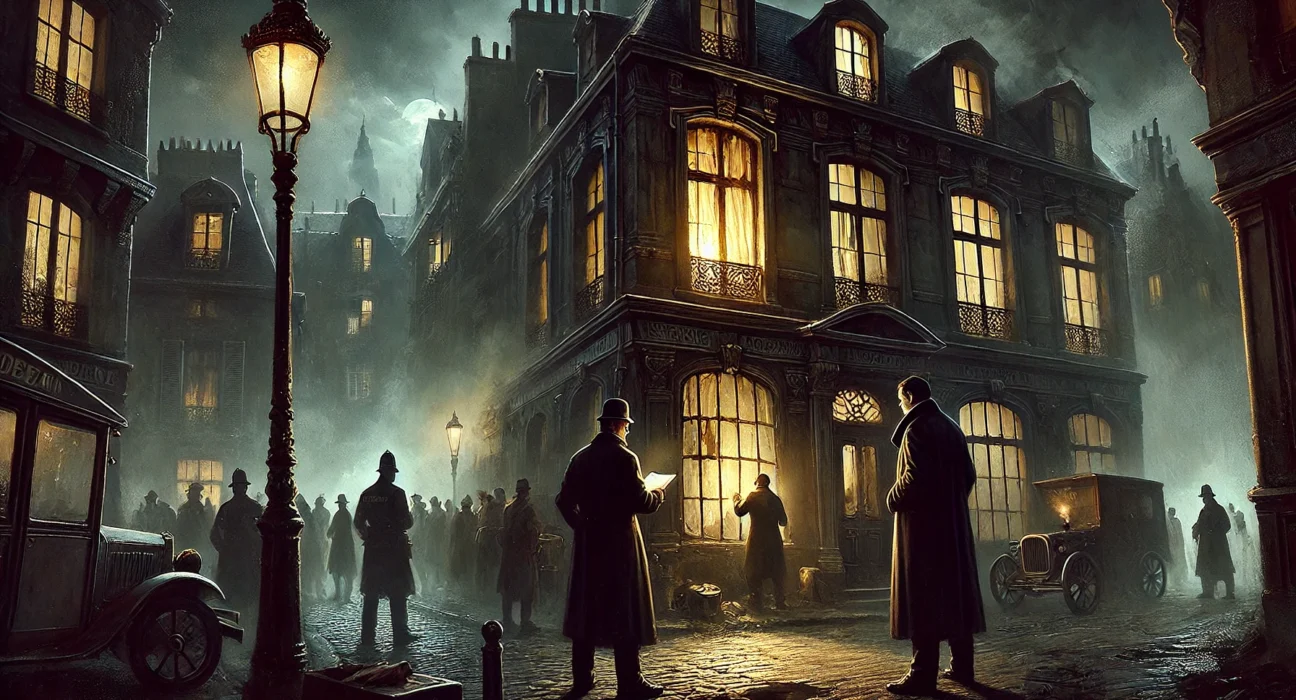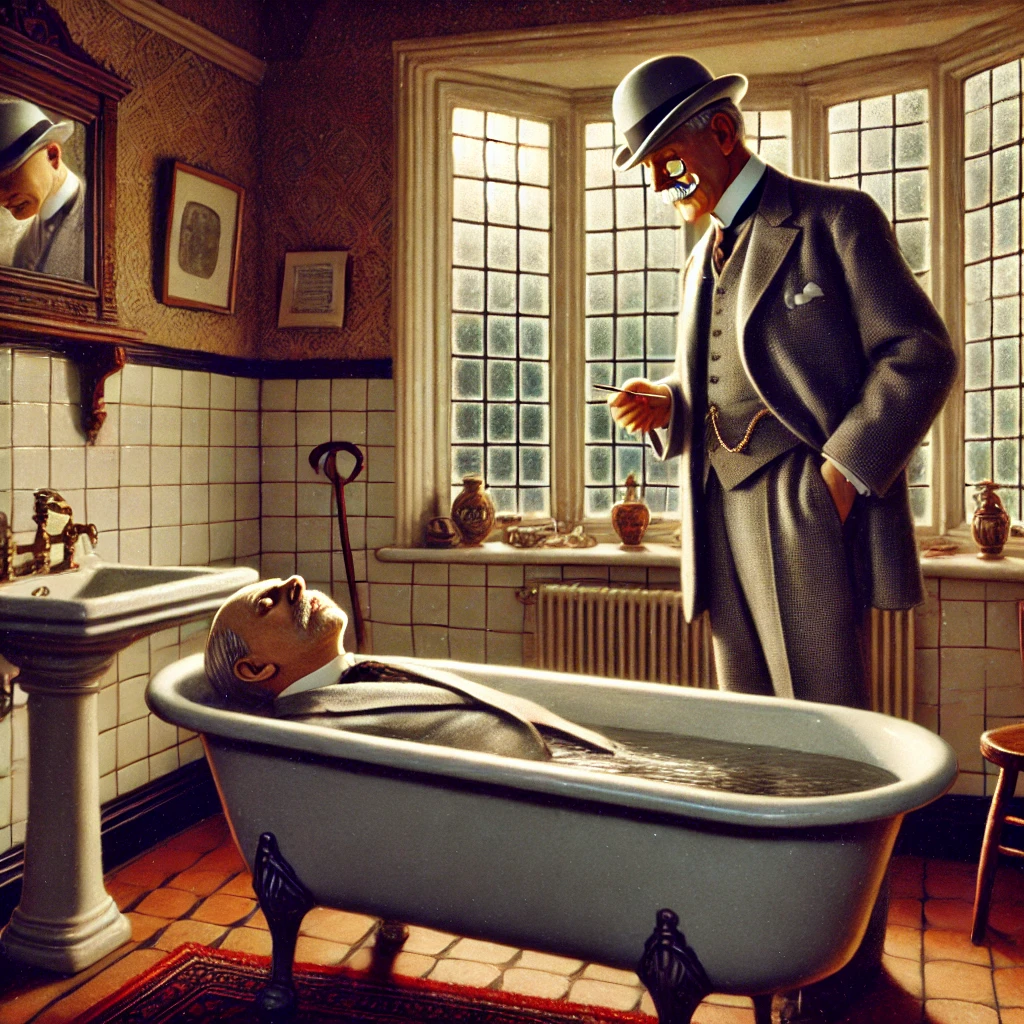The Murders in the Rue Morgue is a short story by Edgar Allan Poe, first published in 1841. It is widely regarded as one of the earliest examples of detective fiction and introduces the character of C. Auguste Dupin, who would go on to appear in two more of Poe’s stories. The tale takes place in Paris, where Dupin uses his brilliant analytical mind to solve a gruesome double murder that has left the police baffled. Poe’s exploration of reason, deduction, and the workings of the human mind laid the groundwork for the modern detective story, making this work a cornerstone of crime and mystery fiction.
Plot Summary
On a dark spring evening in Paris, the narrator recounts his unusual friendship with a man named C. Auguste Dupin. Dupin, a man of remarkable intelligence and a passion for analysis, has fallen into poverty but still manages to live comfortably with his sole indulgence: books. The narrator, captivated by Dupin’s intellect, befriends him, and they soon begin living together in a dilapidated mansion. They spend their days in quiet seclusion, but when night falls, they wander through the streets of Paris, discussing various intellectual topics.
Dupin has a rare ability to unravel complex mysteries by focusing on details that others would dismiss. His analytic mind finds delight in solving puzzles that appear unsolvable, a skill he demonstrates in a conversation where he astounds the narrator by accurately reading his thoughts. It is this ability that leads them to an extraordinary case that grips the entire city.
One evening, Dupin and the narrator are drawn to an account in the local paper detailing a horrifying double murder. The victims are Madame L’Espanaye and her daughter, Mademoiselle Camille L’Espanaye. They were found dead in their home on the Rue Morgue, a crime so violent and grotesque that it leaves the Parisian police baffled. Madame L’Espanaye was found in the courtyard behind the house, her body mutilated, with her throat so savagely cut that her head had nearly separated from her body. Mademoiselle Camille, on the other hand, was discovered wedged headfirst up the chimney of their apartment, her body bearing signs of having been strangled.
The house where the murders took place was found in complete disarray, with furniture overturned and valuables strewn about. There were no signs of forced entry, and the doors were locked from the inside. Witnesses report hearing terrifying screams and voices in strange, unrecognizable languages at the time of the murders. The police are stumped, unable to find any clues that lead to a reasonable explanation or suspect.
Dupin, intrigued by the puzzle, decides to investigate the case on his own. He secures permission from the Prefect of Police to visit the crime scene. Accompanied by the narrator, Dupin meticulously examines every detail of the apartment, paying particular attention to aspects the police had overlooked. While others are puzzled by the chaos, Dupin’s keen eye notices a few small but significant details—marks on the windows, a broken nail, and the unusual arrangement of furniture. After a thorough inspection, Dupin begins to form a theory, one that is so outlandish that it defies conventional reasoning.
As Dupin continues his investigation, he remarks on the witnesses’ conflicting descriptions of the voices they heard. Some claim the voices were French, others insist they were foreign, but no one can agree on the language or nationality. One thing is certain: the voices did not belong to either of the victims. This peculiar detail becomes a key part of Dupin’s deduction.
The next day, Dupin places a curious advertisement in the local paper, claiming to have found a lost orangutan. The ad is intended to draw out a particular individual who, Dupin believes, is connected to the murders. Soon enough, a sailor arrives at Dupin’s apartment, seeking to retrieve the animal. The sailor, nervous and desperate, explains that the orangutan had escaped from his custody. Dupin presses him for more information, and the truth behind the gruesome crime begins to emerge.
The sailor reveals that he had recently captured the orangutan while sailing in Borneo. One evening, the creature escaped from his apartment and, armed with a razor it had picked up, made its way into the Rue Morgue. The sailor, horrified and fearing for the safety of others, chased the animal, but before he could intervene, the orangutan had entered Madame L’Espanaye’s home. It was there that the beast, imitating a human action it had likely observed, tried to shave Madame L’Espanaye with the razor. The situation escalated into violence, and in its primal frenzy, the orangutan killed both women.
The brutal murders were, in fact, the result of an animal’s uncontrolled violence, not a human’s malice. The voices heard by witnesses were the shrieks of the orangutan and the panicked cries of the sailor, who had been trying to retrieve the animal. The creature’s immense strength explained the horrifying nature of the deaths, and the sailor’s subsequent silence stemmed from his fear of being blamed for the killings.
Dupin concludes the case, and the sailor, though distraught, is not held responsible for the tragic events. The orangutan is eventually captured, and the true story of the murders in the Rue Morgue is revealed. Through Dupin’s analytical brilliance, what seemed like an unsolvable mystery, full of strange and terrifying elements, is reduced to a logical explanation: a tale of animal instinct, coincidence, and human fear.
The police, embarrassed by their failure to solve the case, must now acknowledge Dupin’s superiority in matters of reason and deduction. The narrator, filled with admiration, reflects on Dupin’s genius, marveling at how the solution to the horrifying murders had been hiding in plain sight, waiting for a mind like Dupin’s to uncover it.
Main Characters
C. Auguste Dupin: A highly intelligent and reclusive man with a keen mind for logic and analysis, Dupin enjoys solving intricate problems. His motivation is intellectual challenge rather than justice, and his methods rely on a deep understanding of human behavior. He is the prototype for the “armchair detective,” using observation and deduction to solve crimes without the need for physical investigation.
The Narrator: An unnamed companion of Dupin, who serves as both a friend and chronicler of Dupin’s exploits. The narrator admires Dupin’s mind and provides a window for the reader to follow the detective’s thought process. He is largely a passive observer, representing the average person’s amazement at Dupin’s deductions.
Madame L’Espanaye and Mademoiselle Camille L’Espanaye: The two victims of the brutal murders. Their mysterious deaths in their home on the Rue Morgue become the central puzzle of the story. Their violent ends seem impossible to explain, particularly as there appears to be no clear motive and no rational way the killer could have escaped the scene.
Theme
Rationality vs. Chaos: The story explores the triumph of rational thought over chaotic and seemingly unsolvable situations. Dupin’s methodical and rational approach to problem-solving contrasts with the panic and confusion of the witnesses and the police. This theme underscores the importance of logic in making sense of an otherwise incomprehensible crime.
The Power of Observation: Dupin’s ability to notice and interpret subtle details is central to his success. Poe emphasizes the theme of keen observation and the importance of paying attention to what others overlook. This is highlighted by the various clues Dupin notices that the police either miss or misinterpret.
Human vs. Animal Nature: The eventual revelation that the murderer is not human but an orangutan raises questions about the boundaries between human and animal violence. The story plays on the fear of primal instincts lurking beneath the surface of civilization, symbolizing that the line between human reason and animalistic brutality is thinner than we might think.
Social Isolation: Dupin and the narrator lead a secluded life, apart from society, suggesting that genius may require isolation. The two men exist in a bubble of intellectual companionship, a sharp contrast to the chaotic and uncomprehending world outside.
Writing Style and Tone
Poe’s writing style in The Murders in the Rue Morgue is both detailed and analytical, reflecting the story’s focus on logical deduction. He uses a first-person narrative to guide the reader through Dupin’s reasoning, effectively creating a sense of awe and admiration for the detective’s mental prowess. The narrative voice is conversational, with the narrator often engaging directly with the reader, which helps draw the reader into the investigative process. Poe also uses descriptive, almost scientific language when detailing the crime scene and the eventual solution, which reinforces the story’s focus on analysis.
The tone of the story is one of dark intellectual curiosity, tinged with an undercurrent of horror. Poe creates an atmosphere of unease with his depiction of the murders, but this is counterbalanced by the cold, rational approach of Dupin. There is also an element of suspense, as the mystery slowly unravels, but the overall tone remains grounded in the analytical mind of its protagonist, Dupin.
We hope this summary has sparked your interest and would appreciate you following Celsius 233 on social media:
There’s a treasure trove of other fascinating book summaries waiting for you. Check out our collection of stories that inspire, thrill, and provoke thought, just like this one by checking out the Book Shelf or the Library
Remember, while our summaries capture the essence, they can never replace the full experience of reading the book. If this summary intrigued you, consider diving into the complete story – buy the book and immerse yourself in the author’s original work.
If you want to request a book summary, click here.
When Saurabh is not working/watching football/reading books/traveling, you can reach him via Twitter/X, LinkedIn, or Threads
Restart reading!








